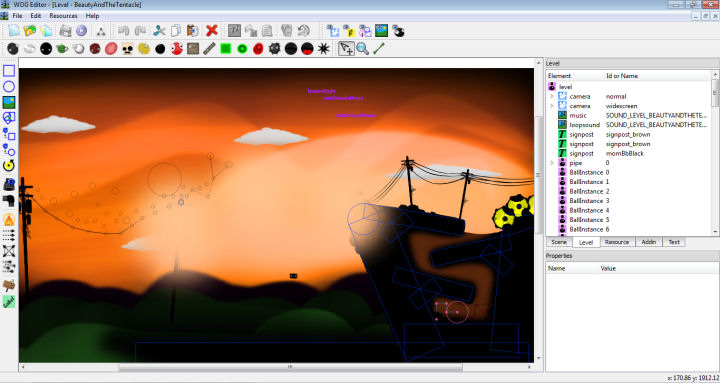
World of Goo Level Editor (aka WooGLE) is a tool for making World of Goo levels
You can create your own levels using your own original graphics and music, or just tweak a level from the original game - or anything in between.
Quick Links: [ FAQ ] [ Reference Guide ] [ My First Level - Tutorial ] [ Download Page ] [ Install for Linux ]

Before you start, you will need...
- A Computer
- The Editor is written in Python and so is fully cross-platform capable. That said, it is apparently far easier to make it work on Windows, and maybe Linux, than on Mac.
- World of Goo
- You will need to have purchased the full game. Windows Users, if you want to play your levels directly from the Editor (and you will want to), you also need to update to the latest version.
- GooTool
- For easy integration of your addins into your or other players games. Get it here.
- World of Goo Level Editor
- The full Windows installation package (and Linux binary package) are available from the download page.
The Very First Thing
The first time you run World of Goo Level Editor it will ask you to locate the WorldOfGoo folder you want to edit.
If you are familar with GooTool you will know that it always preserves the original game files and creates a separate folder which holds the modified version of the game. If you haven't yet, you should run GooTool and create the "modded" folder now.
This is the folder you should use for the Editor, since you should never modify the files in the original game folder. It is often best to create your modded folder in a private folder, be that "My Documents" or your "Home Folder" or on a separate drive somewhere. Wherever you create it, you will need to ensure you have full permissions to read/write/delete files and create folders.
The nickel tour
The Editor GUI is split into several areas: Open Image
The toolbars should be fairly self explanatory - all the buttons have tooltips telling you what they do, just hover of them for a moment before clicking.
The Level View area is a Multiple-Document Interface (MDI), so you can have several levels open at once, and you can minimize/maximize/restore each level view as needed. This also means you can copy and paste things from one level to another (described in more detail later).
Understanding the World of Goo
It will help you to design levels and find your way around if you have some understanding of how World of Goo (and hence the Editor) structures the level data.
World of Goo builds a complete level from 3 main XML files plus other information taken from a number of game-wide (global) files, as well as the actual image and sound files.
The XML files for a level are called Scene, Level and Resources (resrc).
- Scene
- Holds information about how the level looks (graphics, particle effects etc), the geometry (solid things) and other physics stuff (like gravity and wind) that affect the Goo Balls.
- Level
- Holds the information about the Goo Balls in the level, as well as things like where the pipe is, how many goos you need to collect and what music is played.
- Resources
- Holds a list of all the image and sound files used in the level and gives each one an ID. This ID is then used to apply images/sounds to items in the level, rather than using their actual filename.
Tree View Tabs
Each of these files is represented as a Tree View in the Tree Tabs panel. The tree begins at the top with a "root" item: scene, level or resources. All the objects in that file are listed as children underneath the root item. Open Image.
Whenever you add an item to your level, it will be added into one of these trees. You won't need to remember which one, because when you select the item in the graphical view, the entry for it will be highlighted in the Tree, and vice versa.
Properties Pane
When you select any item, a list of its properties/attributes is displayed in the panel below the trees. Open Image. These properties cover every possible value or setting that can be applied to an object of that type.
Some of these you can also change using your mouse (position, size, and rotation) by selecting and dragging objects in the level view. Others you will have to enter or select by hand in the properties pane.
Many of these properties you will never have to touch, except in advanced level designs.
Most items have a few properties that are "essential"; these will be given reasonable default values where possible, but some of them will appear in red to indicate that you must fill something in. Open Image
Next Steps
How about we get started on making "My First Level"...

